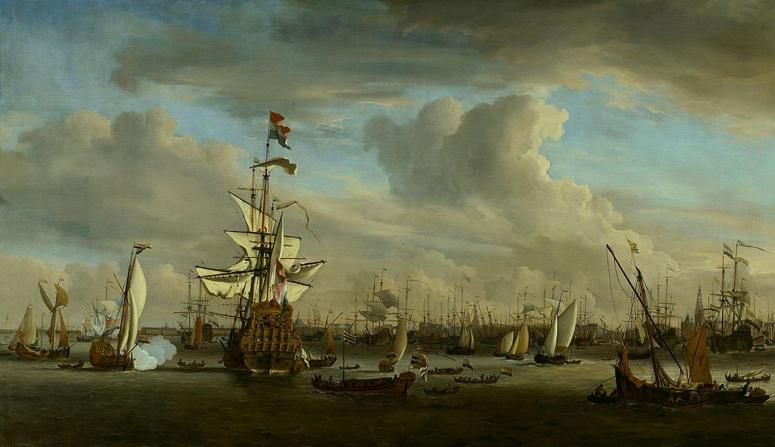Jan van de Cappelle (1626 - 1679). Jan van de Cappelle was a Dutch Golden Age painter of seascapes and winter landscapes, also notable as an industrialist and art collector. He is now considered the outstanding marine painter of 17th century Holland. He lived all his life in Amsterdam, and as well as working as an artist spent much, or most, of his time helping to manage his father Franchoy's large dyeworks, which specialized in the expensive dye carmine, and which he eventually inherited in 1674. Presumably because of this dual career, there are fewer than 150 surviving paintings, a relatively small number for the industrious painters of the Dutch Golden Age. His marine paintings usually show estuary or river scenes rather than the open sea, and the water is always very calm, allowing it to act as a mirror reflecting the cloud formations above; this effect was Cappelle's speciality. His father was a cloth-dyer, his mother came from Rotterdam; they married in 1622 in Amsterdam. Joannes' baptism is recorded in the Nieuwe Kerk, Amsterdam on 25 January 1626. He was described as a self-taught artist, but probably received some form of training from Simon de Vlieger, whose style he copied or is closest to his early paintings, and perhaps other masters such as Willem van de Velde the Elder. He received the citizenship of Amsterdam on 24 July 1653, an essentially honorific ceremony for one of the city elite. A few months before, on 2 February 1653, he had married Annetje Jansdr. Grotingh, the daughter of a bricklayer. Van de Cappelle was a very wealthy man who never needed to rely on his painting for his livelihood, and it is not known if he joined the city's Guild of Saint Luke, or the separate brotherhood of painters founded in 1653. Whether he sold his work, or how he did so, is unclear. Abraham Bredius suggested Van de Cappelle was a friend of Rembrandt, at whose insolvency sales in 1656 and 1658 he was a large buyer, and who painted portraits of him and his wife. It has been speculated that he may have used his business contacts to help obtain the commission for Rembrandt's last, and financially very useful, group portrait commission, the Syndics of the Drapers' Guild of 1662. His earliest dated painting is an important and already highly accomplished one from 1645, and only one is dated in the 1660s. From this most authors assume he devoted his later years to his business, in which his brother Franchois also worked. In May 1661 he bought a house in the Koestraat, near Nieuwmarkt, moving from the even more expensive Keizersgracht. The house with a garden, next to a school, was sold by a son of Sweelinck, and in the deed of purchase van de Cappelle is simply called schilder and not a master painter. His wife predeceased him in 1677, and van de Cappelle himself was buried in the Nieuwe Kerk on 22 December 1679. He left seven children. The inventory of his property at death has survived and is the main source of information about his impressive art collection. It took seven months to list all. He left his children six houses, a country house south of Loenen on the river Vecht, a pleasure yacht, 44 bags of ducats, silk and bonds together valued at 92,720 guilders. A lengthy list of the items from his splendid wardrobe was made, as well as a list of his large and important art collection. The majority of his works are marine or river views, nearly always with several vessels, but he also left a number of small winter landscapes somewhat in the manner of Aert van der Neer; these all seem to date between 1652 and 1654. His seascapes may be large or small; the nine examples in the National Gallery, London, the largest group in a single collection, vary between 122 x 154.5 cm and 34.8 x 48.1 cm. He had no interest in rough seas or cloudless skies, showing large cloudy skies, with the horizon low, about 15-20% of the way up the vertical axis. The clouds are often mirrored in the dead calm water, although light ripples may be shown. As is often the case in Dutch seascapes, there is often a warship or statenjacht, an official yacht used for transport, official salutes and other business. The edge of the composition often slices through vessels, leaving them half seen. Van de Cappelle painted many parade marine subjects, depicting a formal gathering of ships for a ceremonial occasion. Other paintings, mostly smaller and of less busy subjects, a type often called calms, show an all-pervading luminous atmosphere that softens all outlines and unifies forms and local colours, or as Kenneth Clark puts it, When sky was reflected on water, there was achieved that unity of luminous atmosphere which is. the whole point of van de Capelle and van de Velde.
more...











